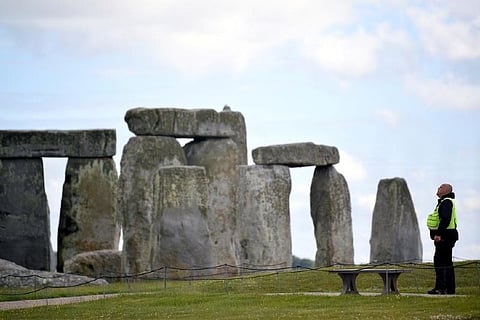

Chennai
Alas, a careless set of measurements results in the musicians playing alongside a model that stands an underwhelming 18 inches high rather than 18 feet tall, a failure showcased on tour and, wincingly, accentuated by the dancing dwarves enlisted to make the prop appear larger.
Thirty-seven years later it turns out that the film’s boulder gag contains a pebble of historical truth. On Friday a team of archaeologists reported in the journal Antiquity that they had unearthed a stone circle in Pembrokeshire, Wales, part of which they believe was dismantled, hauled 175 miles to Salisbury Plain and reassembled as Stonehenge. Mike Parker Pearson, a professor at University College London who led the study, said the stones could have been transported as part of a larger movement of people to the area. “Stonehenge is a second-hand monument,” he said sardonically. The study will be featured in a BBC documentary, “Stonehenge: The Lost Circle Revealed.”
Stonehenge was built in phases from around 3,000 to 1,500 B.C., starting with a circular ditch and bank together with 56 Aubrey holes, a ring of chalk pits that surrounded a stone circle. An excavation in 2008 of one pit, led by Dr. Parker Pearson, revealed that it had held an upright of bluestone, so named because of its bluish-gray hue. The outlying ring of these igneous standing stones, each about nine feet tall, was erected centuries before larger sandstone slabs, known as sarsens, are believed to have originated from West Woods, 15 miles away on the southern edge of the Marlborough Downs.
The geologist Herbert Thomas established in 1923 that the dolerite used to build Stonehenge came from an outcrop in the Preseli Hills of western Wales. In 2011, Dr. Parker Pearson’s team discovered two megalithic quarries in that region and began to search nearby for ritual structures that might have supplied the bluestones and blueprint. Although several circular monuments were surveyed and excavated, none was found to be Neolithic. Dr. Parker Pearson said his investigators had a “terrible time” trying to find evidence of a proto-Stonehenge.
The researchers were about to give up when they returned to a site named Waun Mawn, where a handful of toppled bluestones were seemingly placed in an arc. “The arrangement was first recorded a century ago,” Dr. Parker Pearson said. “The theory by early archaeologists that it might be a circle was largely dismissed or simply ignored.” In 2011, his own magnetometer and earth-resistance surveys had failed to locate any geophysical anomalies that might yield evidence of a circle or monument. “We concluded that since the instruments didn’t show us anything, there couldn’t be anything there,” Dr. Parker Pearson recalled. “A serious mistake.”
During 2017, the archaeologists dug trenches at both ends of the arc of serving stones and discovered two holes that each had once held stones. When further surveys using earth resistance, ground-penetrating radar and electromagnetic induction came to naught, the team made what was literally a last-ditch effort beyond the arc and uncovered four distinctive socket-shaped pits from which standing monoliths had been removed. Dr. Parker Pearson doubts the once popular theory that they came by sea. “Our work has really put a bit of a spoke in that,” he said. “The sources of the bluestones are the quarries on the northern slopes of the mountains, and it seems unlikely that they would have been brought up the steep northern edge before being carried down the southern slopes to the valley.”
Franz Lidz is a journalist with NYT©2020
The New York Times
Visit news.dtnext.in to explore our interactive epaper!
Download the DT Next app for more exciting features!
Click here for iOS
Click here for Android